
Mummies are commonly featured in horror genres as undead creatures wrapped in bandages. Similar undead include skeletons and zombies.

Mummies are commonly featured in horror genres as undead creatures wrapped in bandages. Similar undead include skeletons and zombies.
The mummy genre has its origins in the 19th century when Egypt was being colonized by France and, subsequently, by Victorian Britain. The first living mummies in fiction were mostly female, and they were presented in a romantic and sexual light, often as love interests for the protagonist; this metaphorically represented the sexualized Orientalism and the colonial romanticization of the East. Notable examples of this trend include The Mummy's Foot by Théophile Gautier, The Jewel of Seven Stars by Bram Stoker, The Ring of Thoth by Arthur Conan Doyle, She: A History of Adventure and Smith and the Pharaohs by H. Rider Haggard, My New Year's Eve Among the Mummies by Grant Allen, The Unseen Man's Story by Julian Hawthorne, and Iras: A Mystery by H. D. Everett; the latter actually has the protagonist marry a mummy which takes on the form of a beautiful woman. [1] [2] [3]
Starting from the 1930s, the "romantic mummy" was supplanted by the "monster mummy", pioneered by Boris Karloff in the 1932 movie The Mummy ; mummies thus joined the pantheon of 19th century Gothic monsters, alongside Count Dracula and Frankenstein's monster. [1]
However, the end of the 20th century saw the revival of interest in the "romantic mummy" archetype, starting with the 1989 novel The Mummy, or Ramses the Damned by Anne Rice, which involved a sexual relationship between a benevolent male mummy and a female archaeologist. [1] The trend intensified throughout the late 1990s, the 2000s, and the 2010s: modern works of fiction featuring romanticized living mummies include the 1997 horror fiction novella Don't Tell Mummy by Tom B. Stone, [4] the Inca Mummy Girl episode of the TV series Buffy the Vampire Slayer , the 2006 fantasy novel Freaks: Alive on the Inside by Annette Curtis Klause, and the 2011 video game The Next Big Thing by Pendulo Studios. [5]
During the 20th century, horror films and other mass media popularized the notion of a curse associated with mummies (see Curse of the pharaohs ). The 1922 discovery of Tutankhamun's tomb by archaeologist Howard Carter brought mummies into the mainstream.
Greyhawk, also known as the World of Greyhawk, is a fictional world designed as a campaign setting for the Dungeons & Dragons fantasy roleplaying game. Although not the first campaign world developed for Dungeons & Dragons—Dave Arneson's Blackmoor campaign predated it by about a year—the world of Greyhawk closely identified with early development of the game beginning in 1972, and after being published it remained associated with Dungeons & Dragons publications until 2008. The world itself started as a simple dungeon under a castle designed by Gary Gygax for the amusement of his children and friends, but it was rapidly expanded to include not only a complex multi-layered dungeon environment, but also the nearby city of Greyhawk, and eventually an entire world. In addition to the campaign world, which was published in several editions over twenty years, Greyhawk was also used as the setting for many adventures published in support of the game, as well as for RPGA's massively shared Living Greyhawk campaign from 2000–2008.
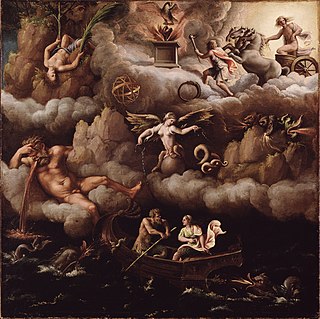
A monster is a type of fictional creature found in horror, fantasy, science fiction, folklore, mythology and religion. Monsters are very often depicted as dangerous and aggressive, with a strange or grotesque appearance that causes terror and fear, often in humans. Monsters usually resemble bizarre, deformed, otherworldly and/or mutated animals or entirely unique creatures of varying sizes, but may also take a human form, such as mutants, ghosts, spirits, zombies, or cannibals, among other things. They may or may not have supernatural powers, but are usually capable of killing or causing some form of destruction, threatening the social or moral order of the human world in the process.
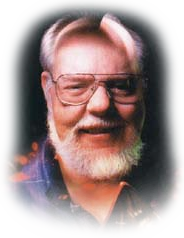
David Lance Arneson was an American game designer best known for co-developing the first published role-playing game (RPG), Dungeons & Dragons, with Gary Gygax, in the early 1970s. Arneson's early work was fundamental to the role-playing game (RPG) genre, pioneering devices now considered to be archetypical, such as cooperative play to develop a storyline instead of individual competitive play to "win" and adventuring in dungeon, town, and wilderness settings as presented by a neutral judge who doubles as the voice and consciousness of all characters aside from the player characters.
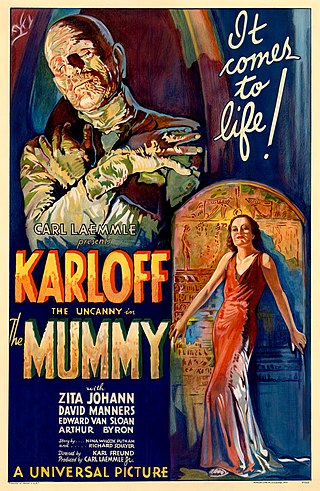
The Mummy is a 1932 American pre-Code supernatural horror film directed by Karl Freund. The screenplay by John L. Balderston was adapted from a treatment written by Nina Wilcox Putnam and Richard Schayer. Released by Universal Studios as a part of the Universal Classic Monsters franchise, the film stars Boris Karloff, Zita Johann, David Manners, Edward Van Sloan and Arthur Byron.

Tomb of Horrors is an adventure module written by Gary Gygax for the Dungeons & Dragons (D&D) role-playing game. It was originally written for and used at the 1975 Origins 1 convention. Gygax designed the adventure both to challenge the skill of expert players in his own campaign and to test players who boasted of having mighty player characters able to best any challenge. The module, coded S1, was the first in the S-series, or special series of modules. Several versions of the adventure have been published, the first in 1978, and the most recent, for the fifth edition of D&D, in 2017 as one of the included adventures in Tales from the Yawning Portal. The module also served as the basis for a novel published in 2002.
An owlbear is a fictional creature originally created for the Dungeons & Dragons fantasy role-playing game. An owlbear is depicted as a cross between a bear and an owl, which "hugs" like a bear and attacks with its beak. Inspired by a plastic toy made in Hong Kong, Gary Gygax created the owlbear and introduced the creature to the game in the 1975 Greyhawk supplement; the creature has since appeared in every subsequent edition of the game. Owlbears, or similar beasts, also appear in several other fantasy role-playing games, video games and other media.
Trolls are fictional monsters in the Dungeons & Dragons roleplaying game.

Vampires are frequently represented in popular culture across various forms of media, including appearances in ballet, films, literature, music, opera, theatre, paintings, and video games.

Kobolds are a fictional race of humanoid creatures featured in the Dungeons & Dragons roleplaying game and other fantasy media. They are often depicted as small reptilian humanoids with long tails, distantly related to dragons.
In the Dungeons & Dragons fantasy role-playing game, the undead are a broad classification of monsters that can be encountered by player characters. Undead creatures are most often once-living creatures, which have been animated by spiritual or supernatural forces. They range from mindless remnants of corpses such as skeletons and zombies to highly intelligent creatures like vampires and liches, but in whatever form they take they are typically malevolent and threatening. Like most Dungeons & Dragons monsters, the various kinds of undead creatures are "drawn from classical, medieval, and fictional sources", and have in turn influenced the use of these kinds of monsters in other games.

In the Dungeons & Dragons fantasy role-playing game, giants are a collection of very large humanoid creatures based on giants of legend, or in third edition, a "creature type".
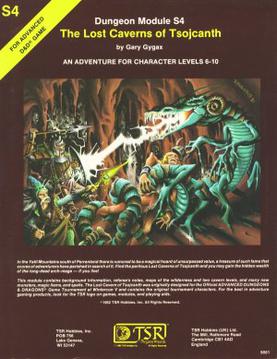
The Lost Caverns of Tsojcanth is an adventure module for the Dungeons & Dragons fantasy role-playing game. It was written by Gary Gygax and published by TSR in 1982 for the first edition Advanced Dungeons & Dragons (AD&D) rules. The 64-page adventure bears the code "S4" and is set in the Greyhawk campaign setting. It is divided into two parts, a 32-page adventure, and a 32-page booklet of monsters and magic items. The plot involves the player characters investigating rumors of lost treasure. After traversing a wilderness and two levels of dungeons, the players face Drelnza, the vampiric daughter of long-deceased archmage Iggwilv.
The lich is an undead creature found in the Dungeons & Dragons (D&D) fantasy role-playing game. Liches are spellcasters who seek to defy death by magical means.
In the Dungeons & Dragons fantasy role-playing game, a vampire is an undead creature. A humanoid or monstrous humanoid creature can become a vampire, and looks as it did in life, with pale skin, haunting red eyes, and a feral cast to its features. A new vampire is created when another vampire drains the life out of a living creature. Its depiction is related to those in the 1930s and 1940s Hollywood Dracula and monster movies. In writing vampires into the game, as with other creatures arising in folklore, the authors had to consider what elements arising in more recent popular culture should be incorporated into their description and characteristics.
The Mummy is an action adventure horror film media franchise based on films by Universal Pictures about a mummified ancient Egyptian priest who is accidentally resurrected, bringing with him a powerful curse, and the ensuing efforts of heroic archaeologists to stop him. The franchise was created by Nina Wilcox Putnam and Richard Schayer.

The original Dungeons & Dragons boxed set by Gary Gygax and Dave Arneson was published by TSR, Inc. in 1974. It included the original edition of the Dungeons & Dragons fantasy role-playing game. Its product designation was TSR 2002.

Blackmoor is a supplementary rulebook of the original edition of the Dungeons & Dragons fantasy role-playing game written by Dave Arneson.

The Dungeons & Dragons Basic Set is a set of rulebooks for the Dungeons & Dragons (D&D) fantasy role-playing game. First published in 1977, it saw a handful of revisions and reprintings. The first edition was written by J. Eric Holmes based on Gary Gygax and Dave Arneson's original work. Later editions were edited by Tom Moldvay, Frank Mentzer, Troy Denning, and Doug Stewart.
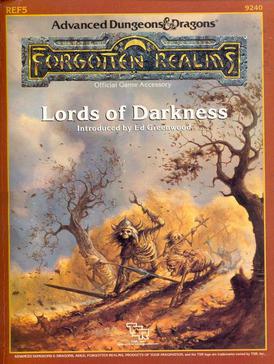
Lords of Darkness is the name of two accessories for the fictional Forgotten Realms campaign setting for the Dungeons & Dragons fantasy role-playing game.

The gargoyle is a fantasy and horror monster inspired by the gargoyle architectural element. While they were believed in mythology to frighten away evil spirits, the idea of such statues physically coming to life is a more recent notion. Like golems, they are usually made of magically animated or transformed stone, but have animal or chimera traits and are often guardians of a place such as a cathedral or castle. They can also be depicted as vessels for demonic possession or as a living species resembling statues.
{{citation}}: CS1 maint: location (link){{cite web}}: CS1 maint: numeric names: authors list (link)